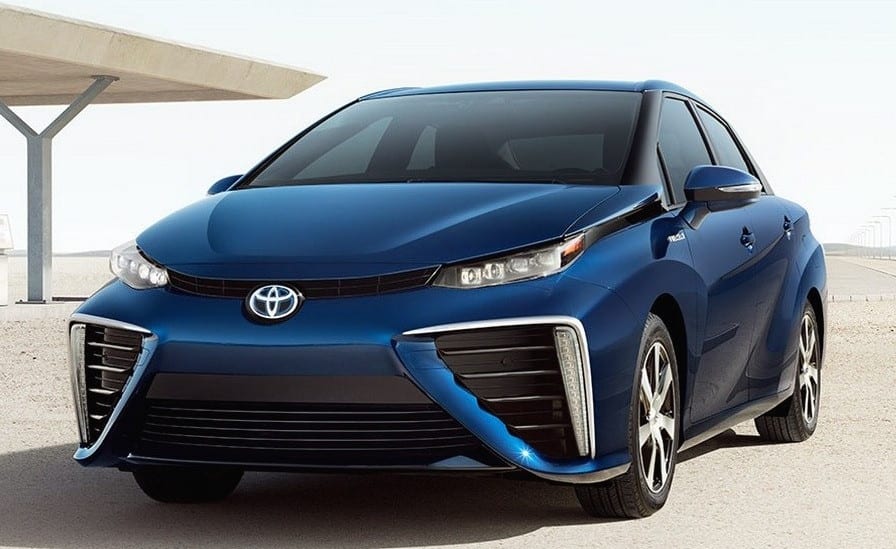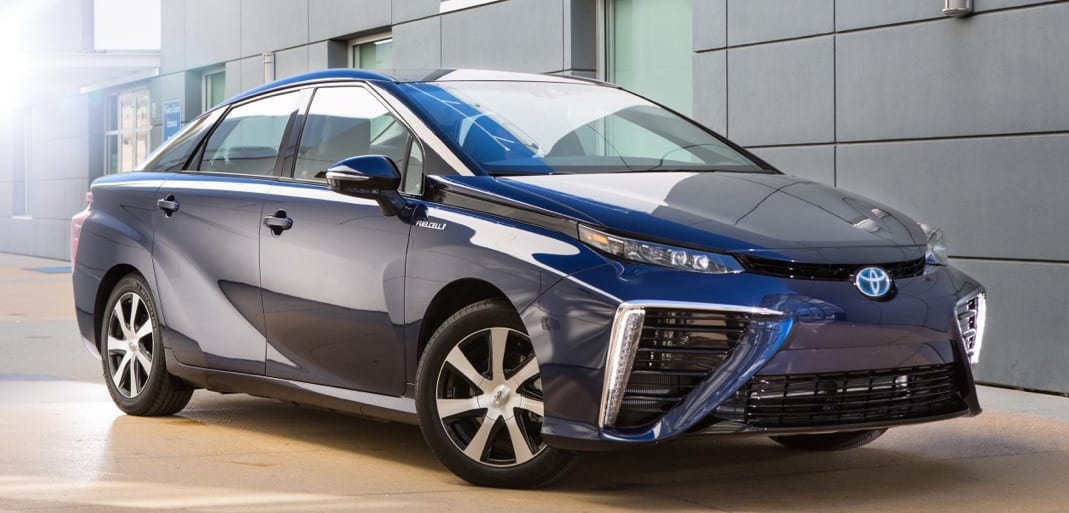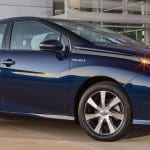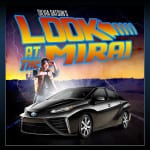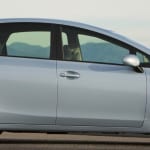Meaning “future” in Japanese, the Mirai is Toyota’s first hydrogen vehicle. After 20 years of working on and improving upon the this project, Toyota has finally completed it and will be ready to release the Mirai by October of this year.
Currently only eight Toyota dealers will be hosting the sales of the Mirai; four in Northern and four in Southern California. Let’s take a look at how this exciting hydrogen powered Mirai will be leading America down a new path of fuel celled vehicles.
How It Works
Even though a fuel celled vehicle, or FCV, has been in the works for Toyota since the same time as work began on the Prius, the practicality of its arrival hasn’t been around as long.
Fuel cells work when the combining hydrogen and oxygen across a catalyst to produce an electric current.
The only by-product of using hydrogen as fuel is water vapor.
Once hydrogen has been pumped into the vehicle, it is stored in carbon fiber fuel tanks where it is then called upon for use.
It’s usage is quite efficient getting an optimum of 300 miles per gallon. 300 miles. That should be enough to make even the biggest skeptics eyes widen.
Hydrogen Power Play
The onboard hydrogen fuel cells generate the electricity which powers the 153 horsepower electric motors. While 153 horsepower can be a less than impressive number, the instant torque of electric vehicles gives the impression of much more power.
The hydrogen tanks and fuel cells are placed in the middle lower of the car which provides a greater center of gravity and with better weight distribution than gas powered cars. This means that it is actually better than its 4,078 lb. curb weight which only adds to its prowess.
Capturing An Audience
While there are currently plenty of hydrogen cars in Japan, the Toyota Mirai is the only mass produced hydrogen car available in America. It is also one of the only FCVs available for purchase rather than just lease.
The Mirai is not the first hydrogen fuel cell vehicle but it is the first released by Toyota and that makes it the first ready to be sold for mass production. Competitively priced at $57,500, Toyota is hoping to capture the same energy conscious audience who have remained loyal fans of the Prius.
Toyota wants to stay ahead and lead the industry in not just battery or electric powered vehicles, but also in hydrogen fueled vehicles.
Production
A hopeful target of 3,000 units to sell or lease through 2017, Toyota is expecting to almost double that number by 2020. Already with 600 units requested for purchase through online marketing, Toyota is not rushing to deliver on the early demand.
Because it’s such a unique car with specific needs, they has a screening process for early interests and early buyers. Toyota has the task of making sure the Mirai is sold and treated responsibly to good customer cliental.
Part of the decision process is based on proximity to hydrogen stations. This does put a bit of a hinderance on the sales of the Mirai, but Toyota has a larger responsibility to make sure the customer experience is optimal rather than just exciting to sell.
To ensure this occurs, they have had to developed an entire customer division around the Mirai.
Positive Customer Experience
Ed LaRocque, Toyota’s national marketing manager for the Mirai, wants to get this right the first time for new their new market. Realizing that the Mirai isn’t the for everyone, Toyota has already decided to be selective with who they sell the car to first.
While this may sound snobbish or even pretentious, the unique demands of the car will require a certain set of knowledge and education. They plan on providing this education to new buyers to create a positive customer experience.
In a Mirai introduction event, guests were treated with a video presentation, education on a hydrogen fuel celled powertrain functions and a half hour test drive.
It was Toyota’s goal to emphasize the importance of knowledge to the first eligible future owners.
Creating Infrastructure

Toyota’s Craig Scott, who is their manager of national alternative fuel sources, recognizes the infrastructure is about ten years behind the Mirai and other hydrogen vehicles already on the roads.
California is currently the most and almost only state prepared for a hydrogen fueled vehicle. Boasting what’s named “Hydrogen Highway”, which is a public/private partnership that started back in 2004 in the hopes of producing a hydrogen transportation economy, California has been ahead of the game and awaiting the Mirai’s arrival for quite some time now.
However, in the 11 years that Hydrogen Highway has been in existence it’s still only part of the 9 hydrogen stations that are currently operational in the state of California.
Because Toyota is in the business of mobility and not fueling, they have teamed up with First Element Fuels and Air Liquide to create the infrastructure needed to support hydrogen fuel stations for hydrogen vehicles.
Hydrogen Stations
There is already planning and funding for 48 more stations to be available. The immediate goal is for 10-15 to be ready and running by the end of 2015. Next year, Scott would like to see another 20 more stations opened.
Hydrogen stations are set up the same as gasoline pumps are. The hydrogen nozzle works the similarly as a gas nozzle and is even has the same placement on the car where the opening for the gas take would be. The difference being that the hydrogen nozzle plugs into a piece on the car and is locked into place for pumping.
Right now hydrogen has a costs of $3-$3.50 GGE (gasoline gallon equivalent) which is certainly comparable to the price of gasoline.
A Car For the Future
So, the Mirai isn’t exactly what I had in mind when imagining “car of the future”. I mean, I don’t exactly see Schwarzenegger stepping out of it warning us about the future of John Connor, or even Marty McFly or Doc doing the same, for that matter.
Truthfully though, the vision I had was based off my 1989 family trip to Epcot Center’s TomorrowLand in Disney World and they said we’d already be in flying cars by now.
What a tease.
The Mirai is a smart and practical, good looking car for the future. It is also probably a more accurate and realistic approach to the look Toyota is headed in.
A bit more bold and pointedly more aggressive in styling, it’s certainly going to catch the eyes of onlookers, but don’t expect pedestrians to notice immediately.
The Mirai is still an electric vehicle, so even though it’s powered by hydrogen it runs just as quiet as Iron & Wine’s first record.
Should you be lucky enough to live in any of the surrounding areas that will be selling the Mirai, expect to keep your eyes open and on watch for it to whisper its way through your neighborhood.
Because there are so many skeptics who look at the stronghold of gasoline on our economy, they just don’t believe that the future of America holds a place for hydrogen fueled cell vehicles. It’s hard to blame them, really. However, technology is progressing.
Regardless of how quickly it catches on, the Mirai is a Toyota made product so we can count on it lasting at least another ten years, even though chances are good it will last a lot longer.
The hope is that the technology and accessibility for alternative fueled vehicles will have improved so much that by that time, the Mirai will already be on its third generation.
